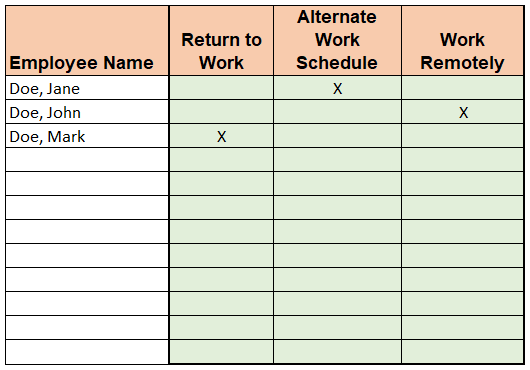UTSA Remote Work Plan
UT System Administration Remote Plan
Definitions and Guidance for Supervisors (also see Policy HRO480 Work Schedules):
Alternate-Day Arrangements – If employees can do only part of their work remotely, departments should consider partial on-site staffing arrangements on alternating days (e.g., half of staff in the office on Monday, Wednesday and Friday and half of the staff in the office on Tuesday, Thursday and Saturday.)
Compressed Work Week (length of workweek) – A compressed work week arrangement allows an employee to work a traditional work week in less than the traditional number of workdays. For example, a full-time employee scheduled for 40 hours per week could work four 10-hour days instead of five 8-hour days. This agreement ensures that the standard number of hours are still worked, but in fewer days. Compressed work week schedules may be negotiated as appropriate.
Staggered Shifts/ Flexible Working Hours (flextime/daily work hours) – When able, supervisors should allow flexibility for the working hours of staff members. Staggering shift start and end times can help reduce office density. Flexible work hours provide an alternative to the traditional 8 to 5, 40-hour work week. It allows employees to vary their arrival, lunch, and/or departure times. Under special circumstances, (KUB/Utility or physician appointments), remote work may be a consideration as well.
Teleworking (working from home/work location) – Under a teleworking (remote work) arrangement, an employee fulfills his or her regularly scheduled job responsibilities from a remote location away from the official workplace on one or more of their working days per week.
Work From Home Information – UTSA July 1, 2021
- Work from Home Considerations
- Set an effective date for employee(s) to begin working from home on a set schedule.
- Work with employees to determine the appropriate schedule (Days at home/Days in the office; work hours).
- Identify in-office and in-home technology & office supply requirements (laptop/desktop, printer, secure internet connectivity, system and file access, software, paper, printer ink, etc.).
- Calculate what personal costs the organization will provide or subsidize (e.g., Wi-Fi, cell phone, printer ink, paper, etc.).
- Determine what needs to be done to remain compliant with relevant laws (e.g., occupational health & safety).
- Based on the situation, identify whether in-person or virtual meetings/training would be appropriate, and clarify expectations.
- Determine and set formal expectations and goals.
- UTSA Alternate Work From Home Form – The purpose of this form is to document the alternate work arrangement (AWA) and approval by the supervisor, unit leader and UTSA Human Resources. AWA will be established following policy HR0380 Work Schedules.
- Contact System Human Resources department for further assistance in planning your UTSA Return to the Workplace process.
Ideas for Supervisors
Consider allowing employees to telecommute when necessary or more optimal:
1. Current State: Document the current state of work-from-home (WFH) at the organization and the unique experience of each work unit that is currently working from home.

2. Work Unit WFH Assessment: Determine the suitability of work units for sustained WFH.
3. Goals & Metrics: Record the goals and metrics to measure the success of the WFH program.
Goals & Metrics

Use this spreadsheet to document the goals and metrics to measure the success of the team-based WFH program. Start by determining the baseline metric and targets for success, then continue to measure progress at various checkpoints.
4. Selected WFH Option(s): Record work units that will be part of the WFH program and the associated WFH option chosen for them.
UTSA Work from Home Planning Detail
5. Program Parameters: Set standard program parameters at the organizational level and variations in parameters at the work unit level to create a framework for the WFH program.
UTSA Work from Home Eligibility
Create systems and documents for managing employees returning to the workplace.
6. Program Enablement: Document the required resources, support, and program changes required to enable the WFH program.
Covid Safety Information
We are here to help! Email your questions to systemhr@tennessee.edu.







